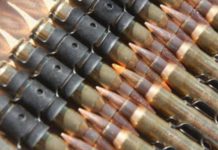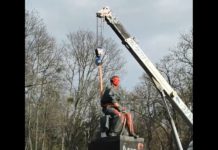By David Cortright* – Bulletin of the Atomic Scientists
Nov 12, 2025
It is now less than 89 seconds to midnight.
President Donald Trump is off on another ill-informed ranting spree, this time claiming that he has ordered the military to resume nuclear testing. In his interview with 60 Minutes last week, he insisted, “we’re going to test nuclear weapons like other countries do.” Trump claimed—incorrectly—that others are testing and vowed, “we’re gonna test also.” If we have weapons, he said, “we have to test ’em.” The same day, Energy Secretary Chris Wright, whose agency is responsible for developing nuclear weapons, tried to walk back Trump’s comments, saying the United States is not planning nuclear explosions “at this time.” It’s head-spinning.
All of this would be ridiculous if the question were not so serious. Starting from probably a misinformed social post, Trump now seems determined to resume nuclear testing, Vice President JD Vance has seconded his proposal, and some Republicans in Congress have cheered it. Arms control advocates are deeply concerned and are warning that the resumption of nuclear testing could trigger “a dangerous chain reaction of testing by U.S. adversaries.” It would end the de facto nuclear test ban that has enhanced global security for more than 30 years. (Russian President Vladimir Putin already said last week that Russia would begin to conduct new nuclear weapon tests should the United States do so.)
Thankfully, Trump’s apparent goal can’t be translated into reality—not quickly nor easily. That will give opponents of nuclear testing time to organize. The technical process of preparing the Nevada test site near Las Vegas will be daunting and could take 18 months or more, depending on the type and scope of the test. This is not to mention the local opposition such a program would face: The state of Nevada is solidly against renewed testing. Sen. Jacky Rosen, a Nevada Democrat, immediately denounced Trump’s first comments and vowed to “do everything to stop it.” Nevada Congresswoman Dina Titus, also a Democrat, introduced the RESTRAIN Act to prevent the United States from conducting explosive nuclear tests.
As the debate over nuclear testing heats up, it may be useful to recall how citizen activism and legislative pressures helped obtain the current US nuclear moratorium and why they will be needed again to preserve it.
Early opposition movement. Congress voted to halt funding for nuclear testing in 1992 following a multiyear campaign of citizen activism and legislative advocacy during the nuclear weapons freeze movement and after. The proposal for a bilateral halt to the testing, production, and deployment of nuclear weapons was enormously popular at the time. The House approved a nonbinding resolution in support of the freeze in 1983, but the bill was freighted with qualifications and caveats and had no policy impact. Activists zeroed in on the demand for a test ban as a concrete step toward implementing the freeze.
The campaign for a test ban received a major boost in 1985 when Mikhail Gorbachev came to power in the Soviet Union and commemorated the 40th anniversary of the bombings of Hiroshima and Nagasaki by declaring a unilateral Soviet moratorium on nuclear testing. Many at the time advocated a reciprocal US response. The National Committee for a Sane Nuclear Policy and the Nuclear Weapons Freeze Campaign launched a nationwide petition campaign for a bilateral testing moratorium that gained more than a million signatures in just three months, an impressive accomplishment in pre-Internet standards.
Then, in 1986, the American Peace Test was formed. The new group sought to mobilize protest and nonviolent civil disobedience at the Nevada test site to demand an end to nuclear testing. Thousands of people from across the country trekked to Nevada and engaged in civil disobedience.
Arms control groups and supportive legislators made the test ban a top priority. Rep. Ed Markey, a Massachusetts Democrat, introduced legislation in 1986 to suspend the funding of US nuclear test explosions above one kiloton of explosive power. The measure was approved in the House by a vote of 234 to 155, although it failed to pass in the Senate. The House approved similar measures to cut funds for testing in 1987 and 1988, but the Senate again failed to go along.
Opposition to nuclear testing was gaining power. But the new administration of President George H.W. Bush was adamantly opposed to a test ban.
Congress passes a moratorium. In 1991, the White House announced an aggressive program of additional underground testing, with several explosions planned over the following years.
Members of Congress renewed the legislative fight in 1992, led in part by Rep. Mike Kopetski, an Oregon Democrat who had participated in the Nevada protests. He and others introduced an amendment mandating a one-year moratorium on US nuclear tests. With disarmament and religious groups mobilizing constituent support across the country, the bill easily won passage in the House.
However, gaining approval for the measure in the Senate remained a challenge. Kopetski’s Oregon colleague, Mark Hatfield, led the Senate fight in cooperation with Democratic Majority Leader George Mitchell from Maine. Senate sponsors broadened the coalition by lining up hawkish Democratic Sen. James Exxon from Nebraska. A revised bill was drafted that established a moratorium for nine months rather than a year, but the bill also called for ending all testing after 1996 and included a mandate for negotiations to achieve a test ban treaty. The new measure passed by a lopsided vote of 68 to 26, and the House agreed to the Senate bill. For the first time, both houses of Congress approved legislation to halt nuclear testing.
An international test ban treaty. Nuclear testing remained a hot issue in the following years, as citizen movements and governments in many countries campaigned for a comprehensive nuclear test ban treaty. In 1993, President Bill Clinton announced the extension of the nine-month testing moratorium and began negotiations for a global halt to all nuclear explosions. In that brief period of friendly US-Russia relations in the aftermath of the Cold War, the talks proceeded smoothly, and an agreement was reached for a Comprehensive Test Ban Treaty.
Although the Senate refused to ratify the treaty, the agreement quickly gained nearly universal international support. It remains functional today as a de facto global nuclear testing moratorium despite the worsening of East-West security relations. The International Monitoring System established by the treaty maintains a rigorous network of 321 stations and 16 laboratories spread across 89 countries to detect potential treaty violations and sustain global consensus against nuclear explosions.
The preservation of that taboo against testing and the security it provides are now in peril because of Trump’s call for renewed testing. Citizen activism and legislative pressures will be needed again to preserve the gains of the past and avoid the risks of a new nuclear arms race.
Featured Image: A group of anti-nuclear test demonstrators, part of a larger group some 1,500 strong, display their message in the streets of New York City on October 28, 1961. In this year alone, the United States conducted 10 underground nuclear tests at the Nevada Test Site and the Soviet Union conducted 59 tests—nearly one per day in the span of three months—after it ended its voluntary testing moratorium in September 1961. (Credit: Getty Images / Bettman)
*David Cortright is a visiting scholar at Cornell University’s Reppy Institute for Peace and Conflict Studies and professor emeritus at the University of Notre Dame’s Kroc Institute for International Peace Studies.
.
We remind our readers that publication of articles on our site does not mean that we agree with what is written. Our policy is to publish anything which we consider of interest, so as to assist our readers in forming their opinions. Sometimes we even publish articles with which we totally disagree, since we believe it is important for our readers to be informed on as wide a spectrum of views as possible.










